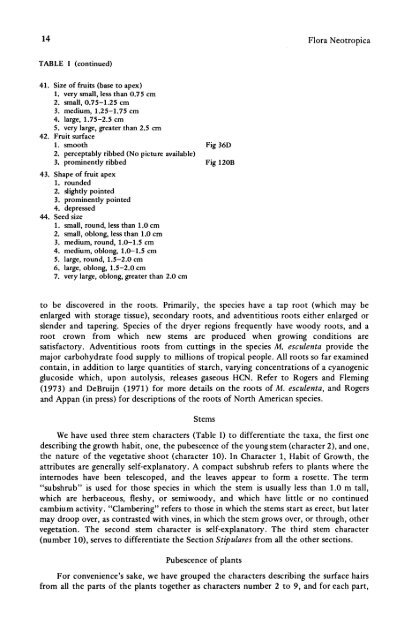Manihot Manihotoides (Euphorbiaceae) - CNCFlora
Manihot Manihotoides (Euphorbiaceae) - CNCFlora
Manihot Manihotoides (Euphorbiaceae) - CNCFlora
You also want an ePaper? Increase the reach of your titles
YUMPU automatically turns print PDFs into web optimized ePapers that Google loves.
14 Flora Neotropica<br />
TABLE I (continued)<br />
41. Size of fruits (base to apex)<br />
1. very small, less than 0.75 cm<br />
2. small, 0.75-1.25 cm<br />
3. medium, 1.25-1.75 cm<br />
4. large, 1.75-2.5 cm<br />
5. very large, greater than 2.5 cm<br />
42. Fruit surface<br />
1. smooth Fig 36D<br />
2. perceptably ribbed (No picture available)<br />
3. prominently ribbed Fig 120B<br />
43. Shape of fruit apex<br />
1. rounded<br />
2. slightly pointed<br />
3. prominently pointed<br />
4. depressed<br />
44. Seed size<br />
1. small, round, less than 1.0 cm<br />
2. small, oblong, less than 1.0 cm<br />
3. medium, round, 1.0-1.5 cm<br />
4. medium, oblong, 1.0-1.5 cm<br />
5. large, round, 1.5-2.0 cm<br />
6. large, oblong, 1.5-2.0 cm<br />
7. very large, oblong, greater than 2.0 cm<br />
to be discovered in the roots. Primarily, the species have a tap root (which may be<br />
enlarged with storage tissue), secondary roots, and adventitious roots either enlarged or<br />
slender and tapering. Species of the dryer regions frequently have woody roots, and a<br />
root crown from which new stems are produced when growing conditions are<br />
satisfactory. Adventitious roots from cuttings in the species M. esculenta provide the<br />
major carbohydrate food supply to millions of tropical people. All roots so far examined<br />
contain, in addition to large quantities of starch, varying concentrations of a cyanogenic<br />
glucoside which, upon autolysis, releases gaseous HCN. Refer to Rogers and Fleming<br />
(1973) and DeBruijn (1971) for more details on the roots of M. esculenta, and Rogers<br />
and Appan (in press) for descriptions of the roots of North American species.<br />
Stems<br />
We have used three stem characters (Table I) to differentiate the taxa, the first one<br />
describing the growth habit, one, the pubescence of the young stem (character 2), and one,<br />
the nature of the vegetative shoot (character 10). In Character 1, Habit of Growth, the<br />
attributes are generally self-explanatory. A compact subshrub refers to plants where the<br />
internodes have been telescoped, and the leaves appear to form a rosette. The term<br />
"subshrub" is used for those species in which the stem is usually less than 1.0 m tall,<br />
which are herbaceous, fleshy, or semiwoody, and which have little or no continued<br />
cambium activity. "Clambering" refers to those in which the stems start as erect, but later<br />
may droop over, as contrasted with vines, in which the stem grows over, or through, other<br />
vegetation. The second stem character is self-explanatory. The third stem character<br />
(number 10), serves to differentiate the Section Stipulares from all the other sections.<br />
Pubescence of plants<br />
For convenience's sake, we have grouped the characters describing the surface hairs<br />
from all the parts of the plants together as characters number 2 to 9, and for each part,

















